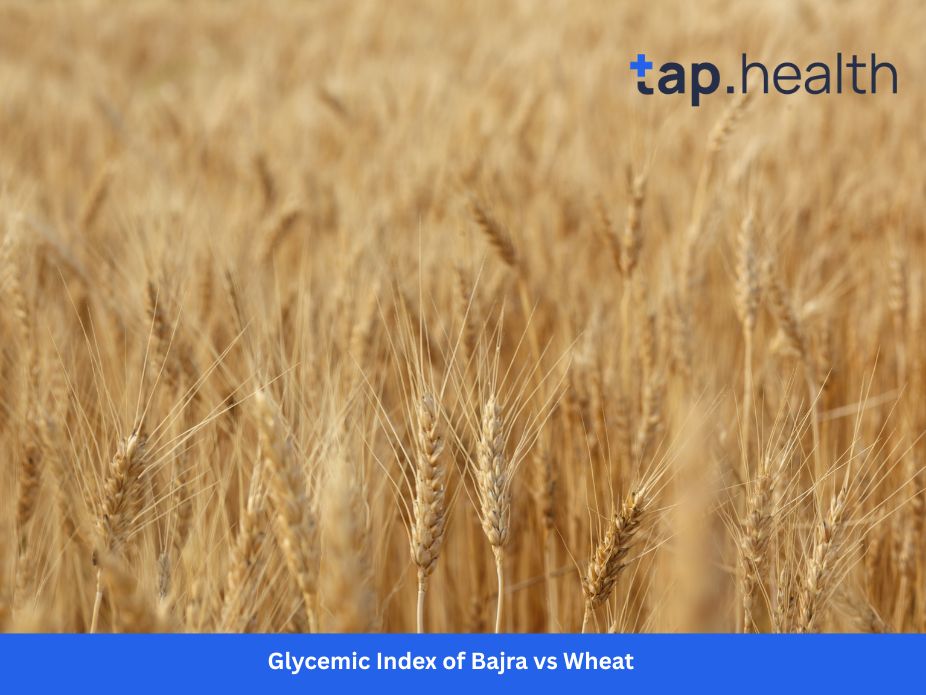When it comes to choosing the right grains for a balanced diet, bajra (pearl millet) and wheat are two commonly consumed options. Both have their unique benefits, but one crucial factor that affects their suitability for certain individuals is their glycemic index (GI).
The glycemic index is a measure of how quickly a food raises blood sugar levels after consumption. For individuals with diabetes, those looking to manage their weight, or anyone aiming for a healthier diet, choosing foods with a low glycemic index is essential. But how do bajra and wheat compare on this scale? Let’s explore the glycemic index of bajra vs wheat, their nutritional benefits, and how they impact your health.
What is the Glycemic Index (GI)?
Before we dive into the specifics of bajra and wheat, let’s first understand what glycemic index means. The GI scale ranks foods from 0 to 100 based on how quickly they increase blood glucose levels after eating.
- Low GI foods (GI 55 or less) release sugar slowly into the bloodstream, helping maintain steady energy levels.
- Medium GI foods (GI 56–69) release sugar at a moderate rate.
- High GI foods (GI 70 and above) cause a rapid spike in blood sugar, which can lead to energy crashes and insulin resistance over time.
For individuals with diabetes or those trying to lose weight, consuming low to medium GI foods is important for maintaining stable blood sugar levels.
Glycemic Index of Bajra
Bajra, also known as pearl millet, is a small, round grain commonly consumed in India and parts of Africa. It’s packed with nutrients like fiber, protein, iron, and magnesium.
Glycemic Index of Bajra: Low to Medium
The glycemic index of bajra ranges between 50 and 55, placing it in the low to medium GI category. This makes it a good choice for individuals looking to manage their blood sugar levels. Since bajra is high in fiber, it helps slow down the digestion process and the absorption of sugars, leading to a gradual increase in blood sugar levels.
Health Benefits of Bajra
Bajra has several health benefits, especially for those with diabetes or anyone looking to improve their overall health:
- Rich in Fiber: The fiber in bajra helps regulate blood sugar levels by slowing down the rate at which sugar is absorbed into the bloodstream.
- Gluten-Free: Bajra is naturally gluten-free, making it suitable for individuals with celiac disease or gluten sensitivity.
- High in Nutrients: Bajra is rich in essential vitamins and minerals, such as iron, magnesium, and B-vitamins, which support overall health, especially for the heart and digestive system.
- Promotes Digestion: The fiber in bajra also aids in better digestion and helps prevent constipation.
How Bajra Affects Blood Sugar
Due to its low to medium GI, bajra has a slower impact on blood sugar levels compared to high-GI foods. This makes it a better option for those aiming to prevent the sharp spikes in blood sugar that can occur after consuming high-GI foods like white bread or white rice. Bajra’s slow-release sugars can help maintain a more stable blood sugar level throughout the day.
Glycemic Index of Wheat
Wheat is a staple grain widely consumed across the globe. It is commonly used to make bread, pasta, and flour-based products. Wheat is rich in carbohydrates, fiber, and protein but its glycemic index can vary depending on how it is processed.
Glycemic Index of Wheat: Medium to High
The glycemic index of whole wheat typically ranges between 50 and 60, which is considered medium on the GI scale. However, refined wheat (like white bread or white pasta) has a higher glycemic index that can range from 70 to 85, which is classified as high GI.
Refined wheat products, like white bread, are processed in such a way that most of the fiber and nutrients are stripped away, leaving behind a higher glycemic content. This results in a quicker rise in blood sugar levels after consumption.
Health Benefits of Wheat
While wheat has its pros, it’s important to differentiate between whole wheat and refined wheat, as they offer different health benefits:
- Whole Wheat: Contains the bran, germ, and endosperm, which means it retains more nutrients, including fiber, B-vitamins, and minerals. Whole wheat helps with digestion and provides a steady release of energy.
- Refined Wheat: While it is low in fiber and nutrients, refined wheat products like white bread cause rapid spikes in blood sugar, making them less suitable for those with diabetes or those managing their weight.
How Wheat Affects Blood Sugar
Whole wheat, with its moderate GI, leads to a slower, more gradual rise in blood sugar compared to refined wheat. However, refined wheat products have a higher GI, which can lead to rapid spikes in blood sugar, especially for individuals with insulin resistance or diabetes.
Thus, when choosing wheat-based products, whole wheat is the healthier option, as it has a lower glycemic index and provides more nutritional value than refined wheat.
Bajra vs Wheat: Which Is Better for Your Health?
Now that we’ve explored the glycemic index and health benefits of both bajra and wheat, let’s compare them side by side to determine which one is better for your health.
Glycemic Index Comparison: Bajra vs Wheat
- Bajra (Pearl Millet): GI of 50-55 (Low to Medium)
- Wheat (Whole Wheat): GI of 50-60 (Medium)
- Refined Wheat: GI of 70-85 (High)
As we can see, bajra and whole wheat have similar glycemic indices, but bajra is slightly better as it tends to be on the lower end of the GI scale, especially when consumed in its natural, unprocessed form. Refined wheat, however, has a much higher GI and should be consumed in moderation, particularly by individuals with diabetes or those managing blood sugar levels.
Nutritional Comparison: Bajra vs Wheat
- Bajra: High in fiber, iron, magnesium, protein, and antioxidants. It is also naturally gluten-free.
- Wheat: A good source of fiber, protein, B-vitamins, and minerals, especially when consumed in its whole form.
Bajra tends to have a richer nutritional profile in terms of micronutrients like iron and magnesium, which support overall health, while wheat (especially whole wheat) offers a good amount of fiber and B-vitamins.
Which Is Better for Blood Sugar Management?
- Bajra: Due to its lower glycemic index and higher fiber content, bajra is an excellent option for those looking to manage their blood sugar levels. It is especially beneficial for diabetics and those trying to avoid sugar spikes.
- Wheat: Whole wheat is also a decent option for blood sugar control but should be consumed in moderation. Refined wheat products should be avoided as they cause rapid blood sugar spikes.
How to Include Bajra and Wheat in Your Diet
Now that you know the glycemic index and health benefits of both bajra and wheat, how can you include them in your diet? Here are some ideas:
How to Enjoy Bajra
- Bajra Roti: Make bajra flour roti for a gluten-free alternative to regular flatbreads.
- Bajra Porridge: Start your day with a warm bowl of bajra porridge, adding fruits and nuts for extra flavor.
- Bajra Salad: Cook bajra and mix it with vegetables and herbs for a healthy, filling salad.
- Bajra Upma: A savory South Indian dish made with bajra, vegetables, and spices.
How to Enjoy Wheat
- Whole Wheat Bread: Opt for whole wheat bread instead of refined bread to ensure you get more fiber and nutrients.
- Whole Wheat Porridge: A great breakfast option that can be made with milk, nuts, and fruits.
- Whole Wheat Pasta: Choose whole wheat pasta for a healthier alternative to regular pasta.
- Whole Wheat Flour: Use it to make chapatis, parathas, or pancakes.
Conclusion
In the debate of bajra vs wheat, both grains have their advantages, but bajra stands out with its slightly lower glycemic index, making it the better choice for blood sugar management. Additionally, it’s nutrient-dense and gluten-free, making it an excellent choice for those with dietary restrictions.
If you’re looking to manage your blood sugar or make healthier dietary choices, incorporating bajra into your meals is a great option. However, whole wheat is still a good choice if you prefer it, just ensure you’re consuming it in its whole form rather than refined products.
FAQ Section
1. Which is better for diabetics, bajra or wheat?
Bajra is slightly better for diabetics because it has a lower glycemic index than whole wheat. This helps prevent blood sugar spikes and promotes more stable glucose levels.
2. Can bajra be eaten daily?
Yes, bajra can be eaten daily as part of a balanced diet. It’s rich in nutrients and fiber, making it a great option for overall health.
3. Is wheat better than bajra for weight loss?
Both bajra and wheat can be part of a weight loss plan, but bajra may be more beneficial because it has a lower glycemic index, which helps control hunger and prevent overeating.
4. Does bajra have more nutrients than wheat?
Bajra is higher in iron, magnesium, and antioxidants than wheat, making it more nutrient-dense in certain areas. However, wheat provides a good source of fiber and B-vitamins.
5. Is bajra gluten-free?
Yes, bajra is naturally gluten-free, making it an excellent choice for people with celiac disease or those following a gluten-free diet.
6. Can wheat lead to blood sugar spikes?
Refined wheat can cause rapid blood sugar spikes, especially when consumed in the form of white bread or pasta. Whole wheat is a better option for more stable blood sugar levels.



